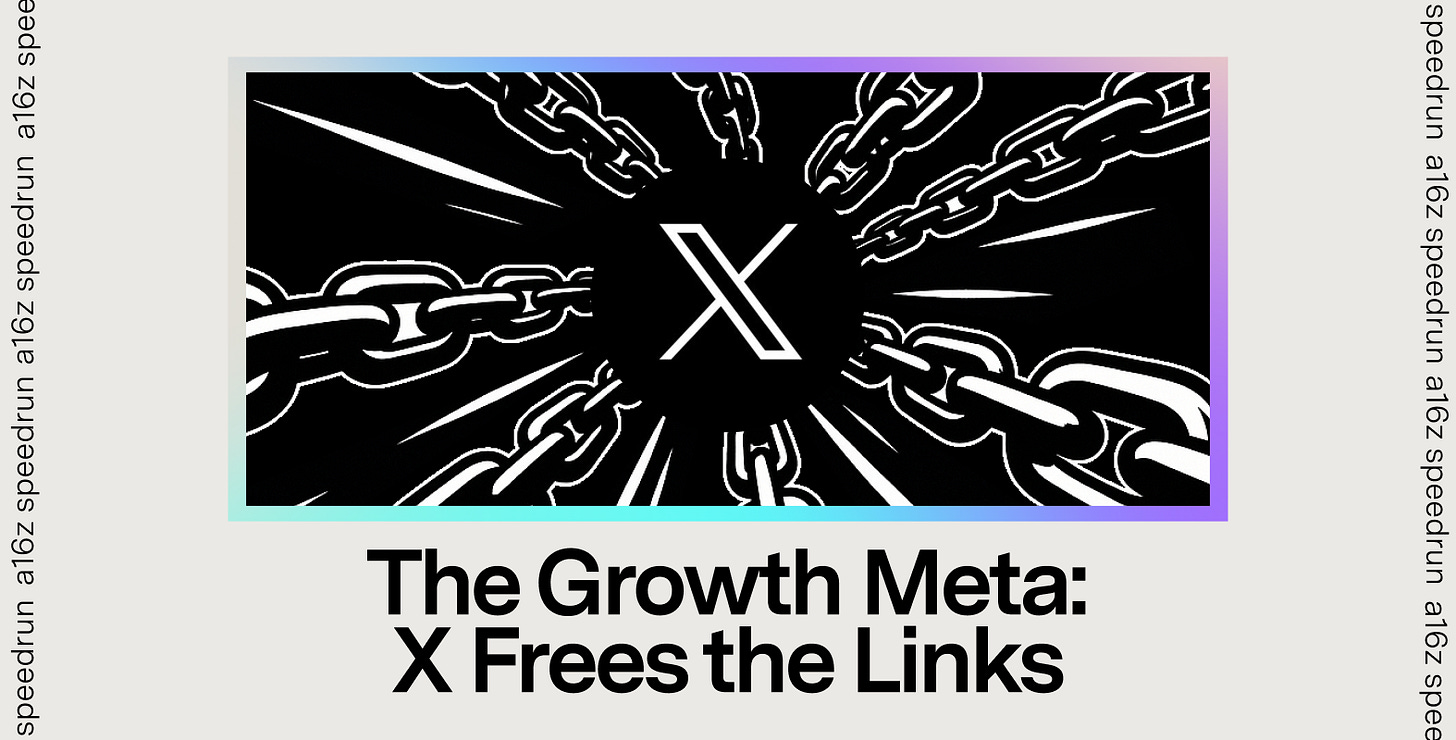The Growth Meta: X Frees the Links
A new mini-series highlighting trends in marketing and growth that can give you an edge.
Tech Week returns next year, and we’re coming to Boston!
The founder-favorite series is back next year: kicking off with Boston’s first Tech Week, May 26–31, and then heading to New York, June 1–7, before wrapping up on the West Coast with San Francisco and Los Angeles in October.
For more info, check out tech-week.com
💡 This Week’s Big Ideas
🧊 Would you give up a “dream job” to chase your childhood dream? Elena Wagenmans of Taya did. This is her story.
🔨 Tom Hammer on why founders should be spending more time recruiting
💫 Bella Nazzari wants you to know about job openings at Taya
🤝 Macy Mills swears she’s super busy at work rn
💼 Join our talent network for more opportunities. If we see a fit for you, we'll intro you to relevant founders in the portfolio.
Marketing is hard for early stage startups. This is not 2015, where you could throw up some half baked ad on Facebook and have a 3x return on ad spend with relatively little effort. Nowadays growth is brutal, cutthroat, and constantly shifting.
To assist founders in our network with growth, we’re starting a new mini-series we call “The Growth Meta.” In these editions, we will highlight some trends in tech marketing/growth that we hope give you an edge. As always, the best compounding advantage in startups is building a kick-ass product, but using the newest growth strategies can act as a multiplier.
Think of this advice like reading the patch notes for your favorite video game—there are always balance updates that give some new marketing weapon a temporary advantage. Here’s what our team is seeing working in the meta right now.
X has freed the links
For many years, we advised startups to not bother posting direct URL links on X. Due to algorithmic suppression, those posts never got enough eyeballs to be worth the effort. With this latest update, it seems X’s leadership team is opening a window for external links to work. Now, when a user clicks on a link, it opens up a minibrowser within the app, where users can still scroll, but on the bottom, they can like, retweet, etc.
After talking with a few founders and experimenting with it ourselves, we’ve found that just posting the link still doesn’t really lead to clicks. Instead, what’s most effective is having a short post, accompanied by a small media asset, which when combined, leads to a curiosity gap.
We’ll define all those terms in a sec, but an example is the most helpful way to show this. Take for example this post by Dan Shipper, where he uses a pithy hook accompanied by an image to make people want to click.
In total this drove 401K views on X, which translated to over 11K clicks on the article for at least a 2.75% click through rate. Not bad! Especially considering that this post likely took 30 seconds to put together and cost nothing.
To replicate this sort of result for yourself, you’ll want to add a couple of ingredients to your poasting:
Punchy copy: Keep your text concise to hook users without overwhelming them. Please, please, please do not use an LLM to write this for you. You can use it to iterate, but you always want to edit it to feel natural and non-performative. The only goal of this copy should be to grab users’ attention and focus it on the core value or hook. For instance, Deji Ajetomobi launched YesCheff with a brief announcement. When paired with a simple video, the post garnered over 1,100 likes and 80,000 views despite a following count under 2k.
Small media asset: Include a lightweight visual like an image or short video to complement your text. You can spend lots on high-end production, or you can just do a Loom with a product demo, the important thing is that it is authentic to your company and the customer set you are targeting. For a fun example, Raul Dronca, a design engineer, shared: “Built this add-to-cart animation with @motiondotdev Demo…” alongside a quick demo video, resulting in over 850 likes and nearly 200,000 views from his 1,100-follower base. It works because the video is eye-catching—and that’s pretty much it. The bar isn’t that high here here, people! Just post authentic stuff that’s fun to look at consistently, and it’ll eventually hit.
Curiosity gap: This is the most important dimension. You have to give people a reason to click. Tease just enough information to create an informational void that users feel compelled to fill by clicking the link, often by hinting at benefits or exclusives without full reveals. Ayush Agarwal announced Dodo Payments with a fun GIF, achieving over 250 likes and over 34,000 views from fewer than 5,000 followers. By promising SEO juice and priority features without spoiling details, it enticed startup founders to submit, turning views into traffic.
The beauty of this strategy is its accessibility. You don’t need a massive following or advertising budget to see meaningful results. As these examples show, accounts with under 5,000 followers are regularly achieving tens of thousands or even 6-figure view counts by combining these three elements effectively.
Now, a word of caution. Like all marketing channels, this window won’t stay open forever. X could change the algorithm tomorrow, or everyone could start using this tactic and flood the zone. That’s why we call this series “The Growth Meta.” These strategies work now, but the meta is always shifting.
Got a growth tactic that’s working for you right now? Reply and let us know.
Like this post? Forward it to your team! And for more weekly dives into the world of early stage startups, subscribe to our own newsletter below.








